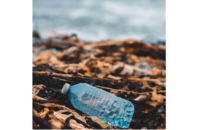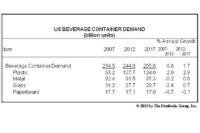Supplier insights
Plastic prospects for food and beverage containers

Submitted by Plastics Color
Plastic food and beverage containers can be shaped in literally hundreds of ways, allowing packaging producers to protect their products while presenting them to consumers in a creative style.
Plastic has become the preferred packaging material for the food and beverage industry, far overtaking glass, metal and paper. Demand for rigid and flexible plastic packaging continues to increase each year, with much of the rise attributed to inventive container forms made possible by new developments in plastic concentrates and liquid carriers.
Among the benefits of plastic containers is the lighter weight of the end-use product, which greatly reduces shipping costs. Plastic also ensures product preservation with an oxygen barrier just as effective as packaging made of glass or metal.
The right plastic for the job
Advances in Polyethylene Terephthalate (PET) and plastic blow molding technology have made possible many innovative containers used in the food and beverage industry. Almost all single-serving and larger bottles of water and carbonated soft drinks sold in the United States are made using PET. Its use is also widespread for foodstuffs such as peanut butter, condiments and cooking oil. Special formulations of PET are used to make food containers that can be microwaved.
Because it does not contain bisphenol-A (BPA) or phthalates (plasticizers), PET has been approved as safe for contact with foods and beverages by the U. S. Food and Drug Administration (FDA) and health-safety agencies around the globe. Plastic Color’s SoluPET, which can be formulated to comply with FDA regulations for food applications and U.S. Pharmacopeia requirements for light transmission, is available in a range of standard colors as well as custom shades upon request. SoluPET masterbatches can be formulated to contain a customer-specified amount of post-industrial regrind to help manufacturers meet recycled product requirements, thus reducing the amount of virgin material needed in the manufacturing process. Plastics Color also can accommodate clients who want their SoluPET-containing product to be produced on one of the clean compounding lines in our state-of-the-art facility.
Branding with color
Beyond the practical benefits of lower weight, providing an oxygen barrier and being shatterproof, a plastic container has to serve a marketing role. Catching the consumer’s eye calls for vibrant color.
LiquiSol™, created by Plastics Color, is a liquid color carrier that can be used in virtually any type of resin system for thermoplastics and in a wide range of applications, including extrusion, blow molding and injection molding. The company welcomes customers to visit its Solutions Center color-matching lab in North Carolina. At this facility, customers and Plastics Color experts work together on custom concentrates and masterbatches to achieve the ideal color for the customer’s containers and packaging.
Visitors also can examine an extensive color library that details everything from stock to special resin colors. Another research tool offered by Plastics Color is color trending, which helps identify current favorites and forecast the trends of tomorrow. The company’s experts perform a complete analysis of a customers’ food and beverage container manufacturing centers as part of a partnership to help them develop the best colorants for their products.
Current trends
The use of plastic for food and beverage containers and packaging will continue to increase. Every year companies seek new ways to utilize plastic for an ever-widening range of food and beverages. A recent example is how health-conscious consumers have boosted the market for nutraceuticals, a niche category that includes dietary supplements and herbal products. The segment is continuing to show growth and plastic has become its packaging material of choice.
However, like their counterparts in the electronics and household goods sectors, food and beverage companies are battling threats posed by counterfeit goods. Though the problem is more prevalent in growing overseas markets, many companies are testing custom product packaging that includes ways to authenticate the manufacturer of origin.
Plastics and potential
One unarguable truth is that people will continue to eat and drink. To meet those needs, the food and beverage industry will be continually looking for containers and packaging that can effectively and attractively deliver its products. Plastic likely will be the material that many of them choose. With its extensive experience, Plastics Color (plasticscolor.com) can help to create the packaging you need for your food or beverage product.
Looking for a reprint of this article?
From high-res PDFs to custom plaques, order your copy today!






